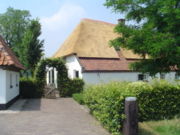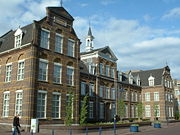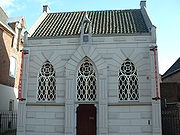
Veghel
Encyclopedia



Municipality
A municipality is essentially an urban administrative division having corporate status and usually powers of self-government. It can also be used to mean the governing body of a municipality. A municipality is a general-purpose administrative subdivision, as opposed to a special-purpose district...
and a town in the southern Netherlands
Netherlands
The Netherlands is a constituent country of the Kingdom of the Netherlands, located mainly in North-West Europe and with several islands in the Caribbean. Mainland Netherlands borders the North Sea to the north and west, Belgium to the south, and Germany to the east, and shares maritime borders...
.
Since 1994 Veghel and the neighbouring village of Erp
Erp (Netherlands)
Erp is a town in the southern Netherlands. It is located in the province of North Brabant, between Den Bosch and Eindhoven. Before 1994, the municipality of Erp included the villages of Boerdonk and Keldonk...
have formed a single municipality.
Veghel is twinned with Goch
Goch
Goch is a town in the district of Kleve, in North Rhine-Westphalia, Germany. It is situated close to the border with the Netherlands, approx. 12 km south of Kleve, and 27 km southeast of Nijmegen.-Cultural ties:...
in Germany
Germany
Germany , officially the Federal Republic of Germany , is a federal parliamentary republic in Europe. The country consists of 16 states while the capital and largest city is Berlin. Germany covers an area of 357,021 km2 and has a largely temperate seasonal climate...
.
Population centres
- BoerdonkBoerdonkBoerdonk is a small village in the municipality of Veghel, in North Brabant in the Netherlands. The village was part of the municipality of Erp until a municipal reorganization in 1994. As of January 2006 it has 794 residents.Community Centre...
- Eerde
- Erp
- Keldonk
- Mariaheide
- Veghel
- Zijtaart
History
The first settlements date back to Roman timesRoman Empire
The Roman Empire was the post-Republican period of the ancient Roman civilization, characterised by an autocratic form of government and large territorial holdings in Europe and around the Mediterranean....
and were established near the River Aa
Aa River (Meuse)
The Aa is a small river in The Netherlands. It rises near Meijel in the southeastern province of Limburg, in the Peel region. It flows northwest through the province of North Brabant towards 's-Hertogenbosch, roughly along the Zuid-Willemsvaart canal. In 's-Hertogenbosch, at the confluence of the...
. The municipality was officially founded in 1310 when Duke John II of Brabant granted the inhabitants the right to use common grounds. Rulers of the municipality were the Lords of Erp, residing at their castle of Frisselsteijn in Veghel.
In 1648 Veghel became part of the Republic of the Netherlands. As a former part of the Duchy of Brabant
Duchy of Brabant
The Duchy of Brabant was a historical region in the Low Countries. Its territory consisted essentially of the three modern-day Belgian provinces of Flemish Brabant, Walloon Brabant and Antwerp, the Brussels-Capital Region and most of the present-day Dutch province of North Brabant.The Flag of...
, Veghel is situated in the Meierij
Meierij
The Meierij van 's-Hertogenbosch was one of the four parts of the former duchy of Brabant, the others being the areas of Leuven, Brussels and Antwerp. It got its name from the Bailiff of 's-Hertogenbosch, who ruled the area in the name of the Dukes of Brabant...
of 's-Hertogenbosch. As a Catholic village, Veghel (like all the other areas of Brabant and Limburg
Limburg (Netherlands)
Limburg is the southernmost of the twelve provinces of the Netherlands. It is located in the southeastern part of the country and bordered by the province of Gelderland to the north, Germany to the east, Belgium to the south and part of the west, andthe Dutch province of North Brabant partly to...
which were transferred to the Netherlands by the Peace of Westphalia
Peace of Westphalia
The Peace of Westphalia was a series of peace treaties signed between May and October of 1648 in Osnabrück and Münster. These treaties ended the Thirty Years' War in the Holy Roman Empire, and the Eighty Years' War between Spain and the Dutch Republic, with Spain formally recognizing the...
) suffered economic and religious oppression from the Protestant Dutch and was counted part of the Dutch military boundary area.
It was not until the French wars of 1795 that Veghel became a free village again and received a guarantee of full common rights from the Dutch government. In 1810 Veghel became part of the Kingdom of the Netherlands
Kingdom of the Netherlands
The Kingdom of the Netherlands is a sovereign state and constitutional monarchy with territory in Western Europe and in the Caribbean. The four parts of the Kingdom—Aruba, Curaçao, the Netherlands, and Sint Maarten—are referred to as "countries", and participate on a basis of equality...
. From the middle of the 19th century the agrarian village began developing into an industrial village as a consequence of the opening of the Zuid-Willemsvaart Canal. The construction of large-scale buildings like the neogothic church by Pierre Cuypers
Pierre Cuypers
Petrus Josephus Hubertus Cuypers was a Dutch architect. His name is most frequently associated with the Amsterdam Central Station and the Rijksmuseum , both in Amsterdam. More representative for his oeuvre, however, are numerous churches, of which he designed more than 100...
and the neoclassical town hall dates from that period. Monastic orders made Veghel a regional centre of health care and education, which it remains to this day.
In 1940 Veghel was occupied by German
Nazi Germany
Nazi Germany , also known as the Third Reich , but officially called German Reich from 1933 to 1943 and Greater German Reich from 26 June 1943 onward, is the name commonly used to refer to the state of Germany from 1933 to 1945, when it was a totalitarian dictatorship ruled by...
troops. With the beginning of Operation Market Garden
Operation Market Garden
Operation Market Garden was an unsuccessful Allied military operation, fought in the Netherlands and Germany in the Second World War. It was the largest airborne operation up to that time....
in 1944 Veghel was one of the dropping-places for Allied paratroops owing to its strategic location.
The period since the 1950s has seen much growth, with the development of new industries and the establishment in Veghel of several international companies. Its shopping centre and marketplace earned the town the name of "Pearl of the Meierij". Veghel is an educational centre for the surrounding district with several secondary schools, a senior secondary vocational school, and one of the oldest higher vocational schools in the area: the Pedagogic Academy, which was founded in 1872.
Local festivals
Every November sees the celebration of the entry of St Nicholas (SinterklaasSinterklaas
Sinterklaas is a traditional Winter holiday figure still celebrated today in the Low Countries, including the Netherlands and Belgium, as well as French Flanders and Artois...
).
Every two year in June or July The Slokdarmfestival takes place.
On 1 September the harbour festival takes place.
In February or March the traditional carnival
Carnival
Carnaval is a festive season which occurs immediately before Lent; the main events are usually during February. Carnaval typically involves a public celebration or parade combining some elements of a circus, mask and public street party...
is held.
Sights
- The neogothic church of St Lambert and its graveyard containing war graves
- The neorenaissance former town hall
- The neogothic former synagogueSynagogueA synagogue is a Jewish house of prayer. This use of the Greek term synagogue originates in the Septuagint where it sometimes translates the Hebrew word for assembly, kahal...
(recently rebuilt) - The Protestant Waterstaat church
- The monasteryMonasteryMonastery denotes the building, or complex of buildings, that houses a room reserved for prayer as well as the domestic quarters and workplace of monastics, whether monks or nuns, and whether living in community or alone .Monasteries may vary greatly in size – a small dwelling accommodating only...
of the order of the Franciscans with its gardens and church

